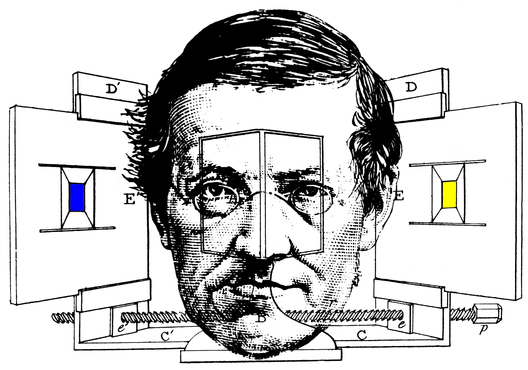Charles Wheatstone1802–1875
Wheatstone invented an instrument that transformed not only the vision of pictures, but also the picture of vision. He made his first stereoscope in 1832, although he did not publish his full description of the experiments conducted with it until 1838. He is shown in his model of the mirror stereoscope. Before the stereoscope, binocular single vision was analysed in terms of visual directions and the Vieth-Müller circle; any points outwith the circle would be seen as double. Wheatstone demonstrated, with the aid of suitably paired figures mounted in the stereoscope, that singleness and depth followed stimulation of slightly disparate retinal points. “The appearances, which are by this simple instrument rendered so obvious, may be easily inferred from the established laws of perspective;… Yet they seem to have escaped the attention of every philosopher and artist who has treated of the subjects of vision and perspective.” The stereoscope opened the way to studying vision with the precision that physicists had applied in their domain: variables like retinal disparity, retinal size, accommodation, and convergence could be studied in isolation in order to determine their role in depth perception. The stereoscope was quickly adopted as a valuable tool in the study of vision, particularly in Germany. Wheatstone himself made several different models including a prism stereoscope and he also invented a pseudoscope, in which the retinal disparities were reversed, resulting in a conflict between different cues for depth. He was quick to appreciate the advantage of a marriage between photography and the stereoscope, and encouraged Talbot to make stereophotographs for him. Wheatstone was born in Gloucester. He was appointed to the chair of experimental philosophy (physics) at King’s College, London, at the age of 32, and held the post for the rest of his life. He invented a number of musical instruments, the most popular of which was the concertina. He is best known for his work in electricity, measuring its velocity and devising a bridging means of measuring resistance. He also devised an electro-magnetic chronoscope. In the 1820s he published work on visual persistence, and constructed a philosophical toy which traced beautiful patterns - called the kaleidophone, after Brewster’s kaleidoscope. He précised Purkinje’s books on subjective visual phenomena and published a translation anonymously. Brewster in his turn devised a lenticular stereoscope in 1849 after seeing Wheatstone’s mirror model demonstrated at a meeting of the British Association. However, Brewster and Wheatstone were fierce anatgonists, and their public dispute over the invention of the stereoscope, aired in the correspondence columns of The Times, reflected nineteenth century science at its most acrimonious. Wheatstone also examined binocular colour rivalry, like that between blue and yellow: “If a blue disc be presented to the right eye and a yellow disc to the corresponding part of the left eye, instead of a green disc which would appear if these two colours had mingled before their arrival at a single eye, the mind will perceive the two colours distinctly one or the other alternately predominating either partially or wholly over the disc”.
